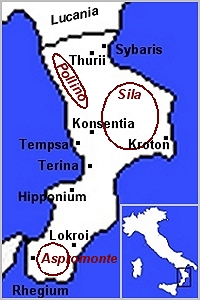پروتيوم
بروتيوم Bruttium هو الاسم القديم لمنطقة في أقصى جنوب الحذاء الإيطالي، which roughly coincides with today's Calabria . Bordered by Lucania to the north, the peninsula is washed by the Tyrrhenian Sea to the west and the Ionian Sea to the south and east. The Apennines cover the interior with the mountain ranges of the Pollino , the Sila and the Aspromonte . Cities were Consentia (capital, today's Cosenza ), Croton , Sybaris , Hipponium , Rhegium , Lokroi Epizephyrioi , Scylaceum and Medma . The inhabitants of the area, the Bruttier (Bruttii), are said to have been renegade Lucanians and that is why they got their name, which is said to have meant “rebels” in the local language.
From the 8th century B.C. The Greek poleis (see Magna Graecia ) that emerged in the coastal plains in the 1st century BC expanded and in turn founded new planting cities . However, the breeding animals continued to live inland. Along with the Samnites , who inhabited Italy's mountainous interior further north, Bruttian tribes conquered Italy in the early 3rd century BC. Some of the Greek cities on the coasts. As allies of Pyrrhus , they were eventually defeated by the Romans , who then occupied large parts of Bruttium. In the Second Punic War (218–201 BC), the Bruttier were allies of Hannibal , and after his defeat their country finally lost its independence to the Roman Empire. The Greek poleis suffered a similar fate. First the Bruttian language disappeared, and later Greek was largely replaced by Latin. In the 6th century AD, after the decline of the Western Rome , the region was finally absorbed into the Byzantine Empire , to which southern Italy was to belong for several centuries. During this time, the Greek language also spread again in the region.
In addition to southern Italian dialects, which are already considered Sicilian in the extreme south, and some Tuscan Arbëresh dialects, Greek dialects are still spoken in some smaller places today.
. . . . . . . . . . . . . . . . . . . . . . . . . . . . . . . . . . . . . . . . . . . . . . . . . . . . . . . . . . . . . . . . . . . . . . . . . . . . . . . . . . . . . . . . . . . . . . . . . . . . . . . . . . . . . . . . . . . . . . . . . . . . . . . . . . . . . . . . . . . . . . . . . . . . . . . . . . . . . . . . . . . . . . . .
أدبيات
- Christian Hülsen : Bruttii . In: Pauly's Real Encyclopedia of Classical Antiquity (RE). Volume III,1, Stuttgart 1897, columns 907–911.
- Mario Lombardo: Bruttii, Bruttium. In: The New Pauly (DNP). Volume 2, Metzler, Stuttgart 1997, ISBN 3-476-01472-X , columns 803–804.
- Loredana Cappelletti: The Bruttii. In: Gary D. Farney, Guy Bradley (eds.): The Peoples of Ancient Italy. De Gruyter, Boston/Berlin 2018, ISBN 978-1-61451-520-3 , pp. 321–336.

